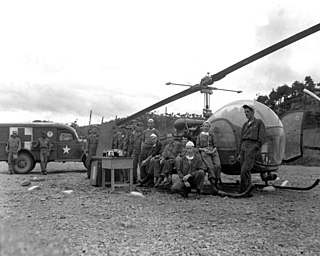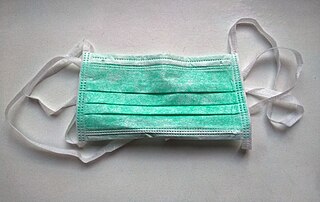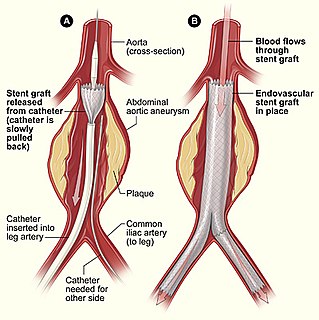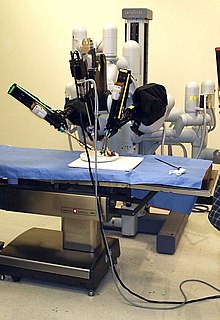Related Research Articles

General surgery is a surgical specialty that focuses on abdominal contents including the esophagus, stomach, small intestine, large intestine, liver, pancreas, gallbladder, appendix and bile ducts, and often the thyroid gland. They also deal with diseases involving the skin, breast, soft tissue, trauma, peripheral artery disease and hernias and perform endoscopic procedures such as gastroscopy and colonoscopy.

Surgery is a medical or dental specialty that uses operative manual and instrumental techniques on a person to investigate or treat a pathological condition such as a disease or injury, to help improve bodily function, appearance, or to repair unwanted ruptured areas.

Laparoscopy is an operation performed in the abdomen or pelvis using small incisions with the aid of a camera. The laparoscope aids diagnosis or therapeutic interventions with a few small cuts in the abdomen.

Appendicitis is inflammation of the appendix. Symptoms commonly include right lower abdominal pain, nausea, vomiting, and decreased appetite. However, approximately 40% of people do not have these typical symptoms. Severe complications of a ruptured appendix include widespread, painful inflammation of the inner lining of the abdominal wall and sepsis.

Mobile Army Surgical Hospitals were conceptualized in 1946 as revolutionized units of ASG Units which were “Auxiliary Surgical Hospitals” made during World War II became obsolete. MASH units had 60 beds, surgical, nursing, other enlisted and officer staff available at all times. Often working long hours to save lives in many wars, MASH Units were in operation from the Korean War all the way to the Gulf War and the remnants slowly disappeared in the early 2000s. MASH units filled a very vital role in military medicine, that was providing close support to army units upwards of 10,000 to 20,000 soldiers. There is also a low mortality rate as a whole coming from these units as the transportation time to hospitals was low resulting in fewer patients dying within the “Golden Hour”. The “Golden Hour” is the first hour after an injury to a person which is referred to in drama as the most important hour. This is because mobility and mortality have the highest chances of being kept for a patient, that is one of the reasons why MASH units were located so close to the front lines. The term was made famous in the novel, movie, and television series M*A*S*H, which depicted a fictional MASH unit. The U.S. Army deactivated the last MASH unit on February 16, 2006. The successor to the Mobile Army Surgical Hospital is the Combat Support Hospital.

Michael Ellis DeBakey was an American vascular surgeon and cardiac surgeon, scientist and medical educator who became the chancellor emeritus of Baylor College of Medicine in Houston, Texas, director of the Houston Methodist DeBakey Heart & Vascular Center, and senior attending surgeon at Houston Methodist Hospital in Houston, with a career spanning 75 years.

Cholecystectomy is the surgical removal of the gallbladder. Cholecystectomy is a common treatment of symptomatic gallstones and other gallbladder conditions. In 2011, cholecystectomy was the eighth most common operating room procedure performed in hospitals in the United States. Cholecystectomy can be performed either laparoscopically, or via an open surgical technique.
Sex reassignment surgery for female-to-male transgender people includes a variety of surgical procedures that alter anatomical traits to provide physical traits more comfortable to the trans man's male identity and functioning.

A surgical mask, also known by other names such as a medical face mask or procedure mask, is a personal protective equipment used by healthcare professionals that serves as a mechanical barrier that interferes with direct airflow in and out of respiratory orifices. This helps reduce airborne transmission of pathogens and other aerosolized contaminants between the wearer and nearby people via respiratory droplets ejected when sneezing, coughing, forceful expiration or unintentionally spitting when talking, etc. Surgical masks may be labeled as surgical, isolation, dental or medical procedure masks.

Oral and maxillofacial surgery is a surgical specialty focusing on reconstructive surgery of the face, facial trauma surgery, the oral cavity, head and neck, mouth, and jaws, as well as facial cosmetic surgery.

Minimally invasive procedures encompass surgical techniques that limit the size of incisions needed and so lessen wound healing time, associated pain and risk of infection. Surgery by definition is invasive and many operations requiring incisions of some size are referred to as open surgery, in which incisions made can sometimes leave large wounds that are painful and take a long time to heal. Minimally invasive procedures have been enabled by the advance of various medical technologies. An endovascular aneurysm repair as an example of minimally invasive surgery is much less invasive in that it involves much smaller incisions than the corresponding open surgery procedure of open aortic surgery. This minimally invasive surgery became the most common method of repairing abdominal aortic aneurysms in 2003 in the United States.

Robotic surgery are types of surgical procedures that are done using robotic systems. Robotically-assisted surgery was developed to try to overcome the limitations of pre-existing minimally-invasive surgical procedures and to enhance the capabilities of surgeons performing open surgery.

Intuitive Surgical, Inc. is an American corporation that develops, manufactures, and markets robotic products designed to improve clinical outcomes of patients through minimally invasive surgery, most notably with the da Vinci Surgical System. The company is part of the NASDAQ-100 and S&P 500. As of December 31, 2019, Intuitive Surgical had an installed base of 5,582 da Vinci Surgical Systems, including 3,531 in the U.S., 977 in Europe, 780 in Asia, and 294 in the rest of the world.
An incisional hernia is a type of hernia caused by an incompletely-healed surgical wound. Since median incisions in the abdomen are frequent for abdominal exploratory surgery, ventral incisional hernias are often also classified as ventral hernias due to their location. Not all ventral hernias are from incisions, as some may be caused by other trauma or congenital problems.
The Master of Surgery is the most advanced qualification in surgery. Depending upon the degree, it may be abbreviated ChM, MCh, MChir or MS. At a typical medical school the program lasts between two and three years. The possession of a medical degree is a prerequisite. The ChM can be awarded on both clinical and academic competency or on academic competency. The regulations may ask for surgical experience and a thesis topic that is not purely medical.
Nephroptosis, is rare and abnormal condition in which the kidney drops down into the pelvis when the patient stands up. It is more common in women than in men. It has been one of the most controversial conditions in terms of both its diagnosis and its treatments.

Adhesions are fibrous bands that form between tissues and organs, often as a result of injury during surgery. They may be thought of as internal scar tissue that connects tissues not normally connected.

Surgical suture is a medical device used to hold body tissues together after an injury or surgery. Application generally involves using a needle with an attached length of thread. A number of different shapes, sizes, and thread materials have been developed over its millennia of history. Surgeons, physicians, dentists, podiatrists, eye doctors, registered nurses and other trained nursing personnel, medics, clinical pharmacists and veterinarians typically engage in suturing. Surgical knots are used to secure the sutures.
Infantile digital fibromatosis (IDF), also termed inclusion body fibromatosis, Reye tumor, or Reye's tumor, usually occurs as a single, small, asymptomatic, nodule in the dermis on a finger or toe of infants and young children. IMF is a rare disorder with approximately 200 cases reported in the medical literature as of 2021. The World Health Organization, 2020, classified these nodules as a specific benign tumor type in the category of fibroblastic and myofibroblastic tumors. IDF was first described by the Australian pathologist, Douglas Reye, in 1965.

Sergey Petrovich Fedorov was a Russian Empire surgeon-urologist, professor of the Imperial Military Medical Academy (1903) and the Imperial Court Surgeon (1913). He is considered the founder of the largest national school of surgery and "the father of Russian urology".
References
- ↑ Hatzinger M, Langbein S, de la Rosette J, Sohn M, Alken P (2007). "[Nephropexy in the course of time : Aspects of an historical surgical technique.]". Der Urologe. 46 (2): 166–9. doi:10.1007/s00120-006-1280-7. PMID 17221244.